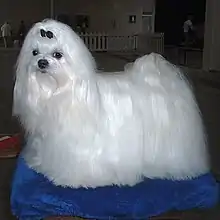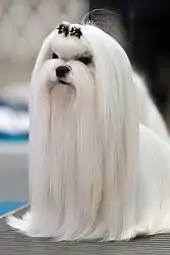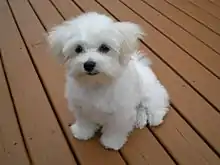Maltese dog
The Maltese is a breed of dog in the toy group. It is thought to have originated in south-central Europe from dogs of spitz type.[3] Despite the name, it has no verified historic or scientific connection to the island of Malta.[4][5]
| Maltese | |||||||||||||||||||||||||||||
|---|---|---|---|---|---|---|---|---|---|---|---|---|---|---|---|---|---|---|---|---|---|---|---|---|---|---|---|---|---|
 Maltese groomed with overcoat | |||||||||||||||||||||||||||||
| Origin | Central Mediterranean Region[1] | ||||||||||||||||||||||||||||
| |||||||||||||||||||||||||||||
| |||||||||||||||||||||||||||||
| Dog (domestic dog) | |||||||||||||||||||||||||||||
History
The Maltese had been recognized as an FCI breed under the patronage of Italy in 1954, at the annual meeting in Interlaken, Switzerland. The American Kennel Club recognized the breed in 1888,[6] its latest standard being from March 10, 1964. Parti-colour and solid colour dogs were accepted in the show ring from 1902 until 1913 in England,[7] and as late as 1950 in Victoria, Australia.[8] However, white Maltese were required to be pure white. Coloured Maltese could be obtained from the south of France.[8]
Little is known about the origin and spread of the Maltese dog. It probably did not originate from the island of Malta, the town of Melita in Italy, nor the island of Melita in the Adriatic, but from spitz-type dogs in south-central Europe, where it may at first have resembled the modern Pomeranian.[3]
Melitaie
The Maltese dog was a lapdog favoured by both the ancient Greeks and Romans, especially their children, and appears on amphorae with the word Μελιταιε (Melitaie).[9] References to the dog can also be found in Ancient Greek and Roman literature.[10] Aristotle mentions the dog around 370 BC. Early writers attribute its origin to Melita, however there were two islands named Melita at that time with one being in the Mediterranean and the other being in the Adriatic sea near Dalmatia, which confuses where the dog originated from.[11][4] Strabo wrote about the Canes Melitei that came not from Malta but from a town named Melita in Sicily, which is in contrast to English writers who give Malta as the place of origin,[12] considering that Melite is also the old name of Mdina, former capital of Malta.
Pliny suggests the dog as having taken its name from the Adriatic island Méléda,[13] however Strabo, in the early first century AD, identifies the breed as originating from the Mediterranean island of Malta.[5][14]
During the first century, the Roman poet Martial wrote descriptive verses to a lap dog named "Issa" owned by his friend Publius.[15] It is proposed that Issa was a Maltese dog, and various sources link Martial's friend Publius with the Roman Governor Publius of Malta,[16] though others do not identify him.[17]
John Caius, physician to Queen Elizabeth I, also claimed that Callimachus was referring to the island of Melita "in the Sicilian strait" (Malta).[18] This claim is often repeated, especially by English writers.[19] The dog's links to Malta are mentioned in the writings of Abbé Jean Quintin, Secretary to the Grand Master of the Knights of Malta Philippe Villiers de L'Isle-Adam, in his work Insulae Melitae Descriptio.[20][21]
Description

Appearance
Characteristics include slightly rounded skulls, with a finger-wide dome, a black button nose and brown eyes. The body is compact with the length equaling the height and the tail is almost always curled. The drop ears with (sometimes) long hair, and eyes surrounded by darker skin pigmentation (called a "halo"), gives Maltese their expressive look. Lacking exposure to a lot of sunlight, their noses can fade and become pink or light brown in color. This is often referred to as a "winter nose" and many times will become black again with increased exposure to the sun. The Maltese's paws are very sensitive to touch.[22]

The coat is long and silky and lacks an undercoat. Some Maltese can have curly hair (especially behind their ears), but this is considered a fault.[23][24] The colour of the coat is pure white. A pale ivory tinge is permitted on the ears. In some standards, a pure white coat with slight lemon markings is tolerated.[25]
The Maltese does not shed, and is therefore a good choice for people with dog allergies.[26][27] They can exhibit signs of tear-staining. Tear stains can be caused by health issues, blocked tear-ducts, or allergies. They can be removed through tear stain wipes, soft chews, and formula that can be placed in their food or water. Tear staining happens on other breeds as well, but it is more prevalent in the Maltese breed because their coat is white. Some people prefer their dogs to have the coat short, clipped to a few centimetres in length.[28]
Adult Maltese range from roughly 1.4 to 4.5 kg (3 to 10 lb). The international FCI standard specifies a weight of 3–4 kg (6.6–8.8 lb);[1] the American Kennel Club calls for a somewhat lighter weight of 4–7 lb (1.8–3.2 kg), with 4–6 lb (1.8–2.7 kg) preferred,[23] They are usually 18 to 30 cm (7 to 12 in) tall.
Uses
The Maltese is kept for companionship, for ornament, or for showing. It is ranked 59th of 79 breeds assessed for intelligence by Stanley Coren.[29]
Abandonment

In 2004, an Australia-wide (not including Tasmania) research project carried out in conjunction with the RSPCA found Maltese owners were the most likely to surrender their dogs to a shelter, citing the tendency of Maltese to bark constantly,[30] and were Australia's most abandoned dog breed.[31] Data released in 2010 by the Korean National Veterinary Research and Quarantine Service show 1,208 Maltese abandoned between January and August 2010, making it the most abandoned breed in Seoul, South Korea.[32]
See also
References
- "Maltese" (PDF). FCI standard No. 65. Archived (PDF) from the original on 2014-08-11.
- "Maltese". Animal Planet dog breed directory. Archived from the original on 2011-07-26. Retrieved 2009-08-29.
- MacKinnon, M.; Belanger, K. (2006). "Ch.5". In Snyder, L.; Moore, E. (eds.). Dogs and People in Social, Working, Economic or Symbolic Interaction. Oxbow Books. p. 43. ISBN 978-1-78570-399-7.
- Lee, Rawdon Briggs (1894). A history and description of the modern dogs of Great Britain and Ireland. (Non-sporting division.). London: H. Cox. pp. 312–322. Archived from the original on 2017-08-09.
- Cramer, John Anthony (1828). Geographical and Historical Description of Ancient Greece. Clarendon Press. pp. 45–46. Retrieved 2009-04-16.
- "Maltese dog breed". 2puppies.com. Archived from the original on 10 May 2016. Retrieved 18 May 2016.
- Foxstone Maltese - Maltese Breed History Archived 2009-02-23 at the Wayback Machine by Sharon Pearson, Eads, Colorado, member of the American Maltese Association, retrieved 2009-04-14
- 'The Maltese of the Past' Archived 2009-07-04 at the Wayback Machine by Trudy Dalziel - Snowsheen Maltese (Maltese Kennel Club of Victoria, Australia) at maltese.com.au, retrieved 2009-04-14
- Johnson, Helen M. (1919). "The Portrayal of the Dog on Greek Vases". The Classical World. XII (27): 209–213. doi:10.2307/4387846. JSTOR 4387846.
- Busuttil, J. (1969). "The Maltese Dog". Greece & Rome. Cambridge University Press. 16 (2): 205–208. doi:10.1017/S0017383500017058.
- Raymond-Mallock, Lillian C. (2005) [1924]. The Up-to-date Toy Dog: History, Points and Standards, With Notes on Breeding and Showing. Read Books. pp. 72–74. ISBN 1-84664-069-5.
- Drury, W.E. (1903). "Ch.59-The Maltese". British Dogs, Their Points, Selection, and Show Preparation. Charles Scribner's sons. p. 574.
- C. Plinius Secundus. The Historie of the World. Book III. Translated by Philemon Holland. pp. 50–71.
- Jean Quintin d'Autun Insulae Melitae Descriptio, 1536, vii, "Huic insulae Strabo nobiles illos, adagio, non minus quam medicinis..."
- Serpell, James (1996). In the company of animals: a study of human-animal relationships. Cambridge University Press. p. 47. ISBN 0-521-57779-9. Retrieved 2009-04-16. Note:refers to a "lap dog"
- Blarney, Edwin Reginald; Charles Topping Inglee; American Kennel Club (1949). The complete dog book. The care, handling, and feeding of dogs; and Pure bred dogs; the recognized breeds and standards. Garden City Publishing Co., inc. p. 622.
- Vioque, Guillermo Galán (2002). Martial, book VII: a commentary. Translated by J. J. Zoltowski. BRILL. p. 467. ISBN 90-04-12338-5. Retrieved 2009-04-16.
- Wentworth (1911). Toy Dogs and Their Ancestors: Including the History and Management of Toy Spaniels, Pekingese, Japanese, and Pomeranians. Duckworth. Retrieved 2009-04-16.
- Bryant, Jacob, Esq. (1807). A New system, or, An Analysis of Antient Mythology: Wherein an Attempt is Made to Divest Tradition of Fable and to Reduce the Truth to its Original Purity. V (3rd ed.). London: J. Walker. p. 359. Retrieved 2009-04-16.
- Jean Quintin d'Autun Insulae Melitae Descriptio (1536).
- "The Maltese dog: a toy for ancient royalty". Times of Malta. Retrieved 29 March 2020.
- The Maltese Dog - Complete Anthology of the Dog. King Lear chapter (further down after opening link).
- "Maltese breed standard". AKC, American Kennel Club. Archived from the original on 2017-10-18. Retrieved 2017-12-16.
- The coat is single, that is, without undercoat. It hangs long, flat, and silky over the sides of the body almost, if not quite, to the ground. The long head-hair may be tied up in a topknot or it may be left hanging. Any suggestion of kinkiness, curliness, or woolly texture is objectionable. Maltese are a pure white, yet sometimes dull gold fur will grow behind their ears and on their back. Light lemon on the ears is permissible, but not desirable.
- "Official Standard of the Maltese" (PDF). American Kennel Club. Archived (PDF) from the original on 2015-09-07. Retrieved 2016-07-16.
- "Are Maltese Puppies Hypoallergenic?". VetInfo. Archived from the original on 2012-10-21. Retrieved 2012-10-06.
- The Dog Selector, David Alderton, 2010, pg 59, ISBN 978-0-7641-6365-4.
- "Maltese". The Complete Book of Dog Care. Retrieved 2016-09-12.
- Coren, Stanley (2006). The Intelligence of Dogs. London: Pocket Books. p. 124. ISBN 978-1-4165-0287-6.
- Dog Dumpage factsheets at Burke's Backyard Archived 2009-01-15 at the Wayback Machine done in conjunction with the RSPCA, Australia, 2004
- Burke, Don. The Complete Burke's Backyard: The Ultimate Book of Fact Sheets, Murdoch Books, 2005, pp 831-832
- "Maltese most abandoned dog in Seoul". The Korea Times. 4 October 2010. Archived from the original on 8 October 2010. Retrieved 4 October 2010.